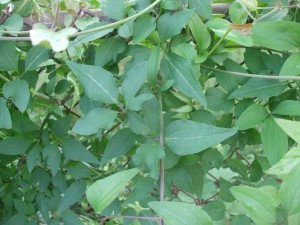

Identification, Biology, Control and Management Resources It is native to Japan and China and was introduced into the United States as an ornamental plant. Clematis terniflora prefers sun to partial shade and is found invading forest edges, rights of ways and urban green space especially near creeks. virginiana) is very similar (margins of leaves of the native tend to be toothed), but not as prone to self-seeding and spreading. Ecological Threat The native species ( C. Seed heads have long, silvery-gray, feather-like hairs attached. Fruit Seeds are also showy and production is prolific. Flowers White, fragrant, four-petaled flowers appear in the late summer through the fall. Foliage The leaves are opposite, compound (with 3-5 leaflets), and the margins are entire. Native Range: Korea ( REHD) Not Found ( BAIL) Īppearance Clematis terniflora is a climbing, semi-evergreen, ornamental vine. Synonym(s): leatherleaf clematis, yam-leaved clematis Taxonomic Rank: Magnoliopsida: Ranunculales: Ranunculaceae Tale of Two Clematis-Terniflora vs.Jump to: Resources | Images | Distribution Maps | Sources.

While Grading Papers the Air Force Arrives.Our customers just like the flowers and the fragrance, with fragrance being an indicator of trouble, sigh

So I am telling my buyers to be careful and to label what we know and what we do not. I am trying to figure out if the Lonicera (honeysuckle) hybrids we sell are native or exotics, invasive or benign, and with all my connections I am still confused and for the time being at a lost to find definitive answers. I am simpathetic to your identification trials. The collections of USDA ARS, now on a hit list of sorts are crucial to this work "Invasive Notes". Correct identification of plants and pests is critical to gardening and the preservation and enhancement of natural areas. I also serve again as an unpaid volunteer as Secretary of the National Invasive Species Council Advisory Committee, meeting next week in Alaska, May 2008.
#Clematis terniflora leaves full#
I am working as a full time volunteer to reverse this trend in government as far as research into the fields of foods, fuels, fibers, flowers, and forests, know as USDA. Unfortunately, our government has decided because of cost to restrict and limit the on-going research, so in the end the nurseries will be on their own. This provides me with a font of "right" information to the best of the collective wisdom of the US government to date. National Arboretum close to our nursery, and with researchers at the Beltsville Agricultural Research Center (BARC) and the good folks at the National Agricultural Library (NAL). I am fortunate to work with scientist from the U. The challenge of correct identification can be most interesting. The market place is a great enforcer if the public chooses to exercise some of its pocket power. Knowing what you are selling should be a matter of pride, and the consumer should enforce this pride by choosing only nurseries which effectively over the long run provide the most accurate information possible. Of course we all know that every business makes tons of profit which explains why our stock market is doind so well no matter which company one invests in. As to "no matter the cost", well unfortunately business has to pay the government first (taxes), the lawyers second, followed by the bank and employees, which then are followed by actually paying the people who sold the nursery the plants in the first place. It is interesting to think of nurseries being just like government, always right.


 0 kommentar(er)
0 kommentar(er)
